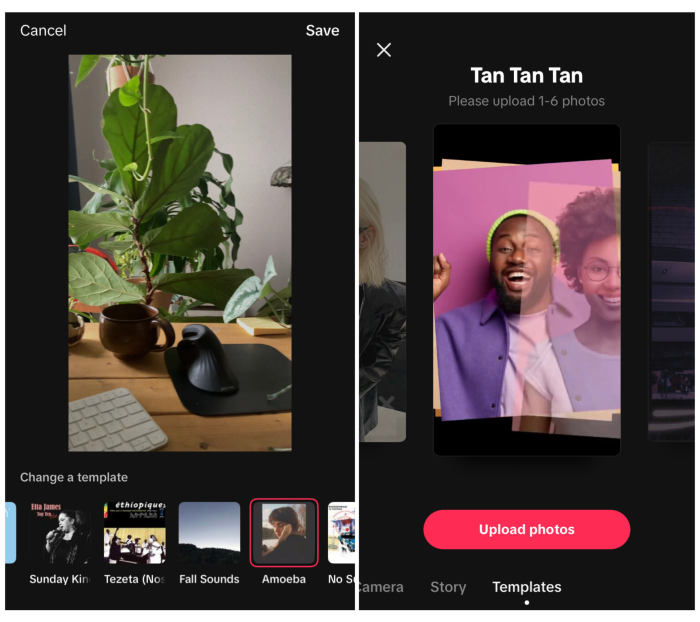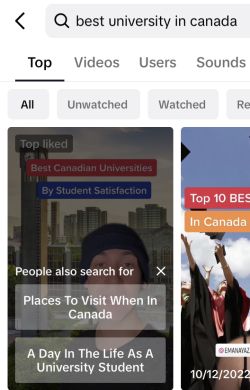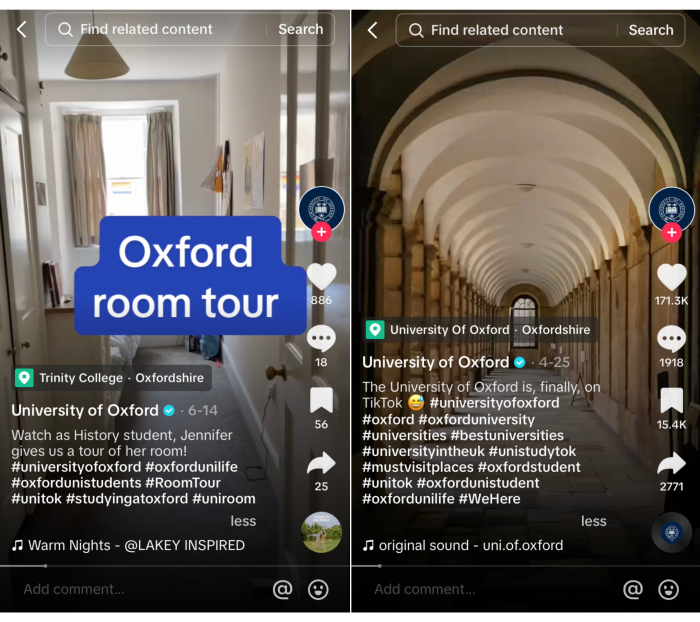It is not a secret that since its release in 2016, TikTok has become one of the most popular social media platforms worldwide, particularly among younger demographics. With over 3.5 billion downloads worldwide, TikTok is the place where young generations go to look for entertainment, news, tips, and all sorts of information. This could be attributed to TikTok has tapped into the demand for visually appealing content. The platform’s popularity is such that last year Prabhakar Raghavan, a Google senior vice president, acknowledged that younger users are turning to the video app to search for places and recommendations instead of using Google services like maps or search. So, while Google remains the go-to search engine for many, TikTok is slowly becoming the preferred search engine for some Millennials and most Gen Z users.
Given that Gen Z is the demographic that is currently in school or approaching college age, schools should use this opportunity to tap into TikTok’s user base to engage with prospective students. Here, we’ll provide some insights to help you discover TikTok’s search culture and understand how your school can exploit this trend.
Understanding Tiktok’s Demographics and Statistics
TikTok is a popular social media platform that allows users to create, view and share short videos, typically ranging from 15 to 60 seconds. The app offers various creative tools, effects, and filters, enabling users to showcase their talents, share witty or informative content, and engage with their preferred communities. In general, users like to film themselves dancing, produce original short videos, participate in challenges, share educational content, and consume videos the algorithm suggests based on their interests.
Example: TikTok users have endless possibilities to express themselves creatively, from templates to remixes and filters. By having new trends all the time, TikTok keeps users interested in creating fresh content.

Is your school struggling to create engaging organic and paid TikTok content? At HEM, we can help you launch and optimize your TikTok strategy. Contact us for a free consultation.
With over 1 billion monthly active users, TikTok has positioned itself as an important marketing channel in higher education, allowing schools to reach prospects through interactive and engaging content. Although Facebook, YouTube, and Instagram remain among the most popular social media platforms, schools might be surprised to learn that Gen Zers tend to favour TikTok over Instagram.
Example: In this post, the University of Toronto uses the trend “Wes Anderson Style” to tour its centre for experiential education outside the classroom (Hart House).

Source: University of Toronto
Pro tip: If you are new to TikTok, start by understanding how to search on TikTok. Learning how the platform works and how users interact with the interface will help your marketing team discover TikTok’s new trends and create content that resonates with your audience.
To understand TikTok’s popularity and search culture, it is important to have an overview of its demographics. Here’s a breakdown of TikTok users by age group:
- Ages 10-19: 25% of users.
- Ages 20-29: 22.4% of users.
- Ages 30-39: 21.7% of users.
- Ages 40-49: 20.3% of users.
- Ages 50+: 11% of users.
In addition, schools should also keep in mind that TikTok users spend an average of 95 minutes per day (over 1.5 hours) on the platform. Given its rising popularity, schools off TikTok should be trying to determine if having an account on the platform would contribute to their enrollment goals.
Why Is TikTok So Popular?
One factor that could explain TikTok’s popularity is its algorithm. TikTok’s algorithm uses artificial intelligence to personalize the content feed, making it highly addictive and tailored to each user’s interests. For instance, if a person uses the TikTok video search tool to look for “universities in Canada” and engages with a few of the videos that use the keyword, the algorithm will later serve the same person similar content through the “For You” page, as seen in the example below.

In addition, the fact that users get served content that appeals to them makes it easy for them to discover Tik Tok communities they can feel part of. Schools can use this to increase social media engagement by creating videos that appeal to study communities. Topics like study tips, study tours, a day in the life of a student, and university fun facts are highly popular and can improve your school’s visibility within the platform. In the following video, for instance, Algonquin Careers Academy offers a tour of its pharmacy to help prospective students understand the environment in which they will be learning once they join the school.

Source: Algonquin Careers Academy
Pro tip: Before your school starts sharing videos on TikTok, ensure your TikTok marketing strategy aligns with your content strategy. This will ensure that the content you record and share is aligned with your overall marketing goals.
Another reason that could be behind TikTok’s success is that the platform capitalizes on the demand for short-form video content. A study suggests that 61% of Gen Z and Millenials prefer watching short videos. and it is estimated that over 91% of people would like to see more video content from brands. This demonstrates that video content is not only an incredibly important form of entertainment but also essential for promoting services. If your marketing team has been attentive, you would know that most platforms, from YouTube with Shorts to Instagram with Reels, have been trying to address this demand. Staying on top of these video trends is key to ensuring your school gets as much visibility as possible.

What is the TikTok Algorithm?
Before diving into TikTok’s search engine potential, it is important to understand how the platform’s algorithm works. TikTok’s algorithm uses three parameters to suggest videos to TikTok users:
- User interactions: likes, comments, shares, time spent on the video, times the video was watched, TikTok history search, or any activity that occurs while watching videos. The algorithm also considers accounts followed, sounds users have listened to, videos marked as favourite, and content created.
- Video information: captions, hashtags, effects, trending topics, and songs used in the video.
- Device and account settings: Language, country, device type, and categories of interest selected as a new user.
Understanding these parameters can help your school’s marketing team discover TikTok’s potential. Although schools can only control video information, they can encourage students and prospects to interact with their page by asking them to participate in challenges or by showcasing their achievements through the platform.
Example: University of Florida’s branded hashtag #ufgrad has over nine million views. Students, graduates, and staff members are encouraged to use the hashtag to show their pride and appreciation for the school. When a student shares a post using the hashtag and one of their followers likes it, the likelihood that the algorithm suggests content shared by the university increases.

Source: University of Florida
Pro tip: The algorithm won’t recommend content that has been watched, so it is recommended that schools should have a regular posting schedule.
Discover Tiktok’s Search Engine Potential
It is estimated that 40% of Gen Zers prefer using TikTok for search instead of conventional apps like Google. This could be justified by the fact that videos make content more digestible. A recent study revealed that 96% of people have watched a video (not necessarily TikTok) to learn more about a product or service, and it is believed that about 70% of millennials watch videos to learn how to do something new.
Example: TikTok users can look for various study-related content on the platform from study tips to the best cafes to study in town. Once a user engages with one of the videos, TikTok’s algorithm will also offer to “Find related content” (top of right image).

Another aspect that makes using TikTok as a search engine more appealing is that the platform offers users up-to-date and quickly-delivered information. New videos are posted daily, which ensures that the information users find through the platform is relevant and timely. In addition, TikTok’s appeal as a search engine comes from its user community. User-generated content provides diverse perspectives, uses different language registers, and features real-life experiences, which can make things more relatable for young users looking for information on the platform.
TikTok is aware that users engage with the platform for more than entertainment. Over the past months, the company has slowly added different search engine features to its interface and encouraged users to “use TikTok to discover the world, watch culture unfold through our diverse communities, and learn new things every day.”

Last September, TikTok expanded its post description length from 300 to 2,200 characters, which means that users are now allowed to include more keywords in their post descriptions. In addition, TikTok now features an “others searched for” section, similar to Google’s “related searches” section, which works in parallel with the auto-fill feature that TikTok’s search bar already had.

Source: TikTok (Left) and Google (Right)
When looking for videos, users may also get suggestions about the content other users searched for after watching the video, as seen in the example below. This only emphasizes the need for schools to up their game when writing optimized and compelling captions for their TikTok videos. To search on TikTok, tap on the search icon, enter a keyword or a word related to what you are looking for, and then tap search.

Source: TikTok
Pro tip: If your school is not using social media to reach your enrollment goals, an excellent place to begin would be to find out what platforms your prospective students are using and open branded accounts to connect with them.
TikTok SEO: What Schools Can Do to Make Their Content More Discoverable
Now that you’ve unlocked the secrets of TikTok’s search culture, it is time to dive into how your school can profit from this trend. The first step is to understand what social SEO means. Likely, your school’s marketing team is optimizing your website, online content, and digital strategy to improve visibility and ranking in search engine results pages. Social SEO is not much different from this. It adds text-based features such as hashtags, keywords, and location to your social media posts to make content more discoverable. Although this may sound basic, you might think, “Isn’t that what social media is about?” understanding the right keywords and hashtags specific to your target audience and industry is like uncovering the secret code to unlock their attention.
Example: In these two videos, the University of Oxford uses a mix of branded hashtags and keywords (#oxforduniversity #oxfordunilife) and more organic ones (#roomtour #mustvisitplaces) to increase engagement.

Source: Oxford University
Is your school looking for help to create engaging TikTok content? Let us help you create and optimize your TikTok strategy.
TikTok SEO Tips
A few tips can make your TikTok SEO optimization easier, but it all begins with the TikTok search bar. Likely, your team has already identified the keywords your school should use to improve its website SEO. You can use those as a starting point and use the search bar to discover what other keywords the platform is associating your keywords with.
Example: TikTok will automatically suggest other keywords and hashtags when you start typing your keywords and long-tail keywords. You can write these down and do further research to see if the content shared under these keywords is aligned and relevant to your goals. Can’t I search for videos on TikTok? If your TikTok search bar is not working, try to log out of your account, close the app, and log back in. If this doesn’t work, delete and reinstall the app.

Source: TikTok
Pro tip: As you can see, although the keyword “study cafes Montreal” is not directly related to the school’s promotional content, TikTok’s algorithm has grouped this keyword with the hashtag #studyinmontreal. This means that users looking for places to study might also be served content that uses the hashtag #studyinmontreal and vice versa. Schools that wish to create dynamic content can take advantage of this and create content that is not promotional but catches prospective students’ attention.
Another tool that schools can use to find the correct terms is TikTok’s keyword insights tool. You can use it to identify top-performing keywords and phrases from TikTok ads to improve your copy. This tool allows you to look for keywords and refine your search by specifying what country, industry, objective type, and keyword you are targeting.

Once the keyword has been introduced and identified, a report will be created:


Once keywords are identified, it is recommended that schools include some of those keywords in three places: on-screen text, captions and hashtags, and automated closed captions (for this one, the person speaking should verbally say the keyword). It is also recommended that the location is added.

Finally, just as important as it is to understand the keywords your audience is using and looking for, it also is essential to understand the kind of videos they like to see. As you can observe, most schools create video content that adds value to their feed and resonates with their audience. To improve engagement and visibility, watch TikTok trends and see how you organically engage with them. Your school can also share educational content, student-generated content, content created by student ambassadors, and content about diversity and inclusion. Incorporating all these TikTok SEO strategies can help your educational institution achieve online visibility, improve engagement, and establish an enduring relationship with students.







